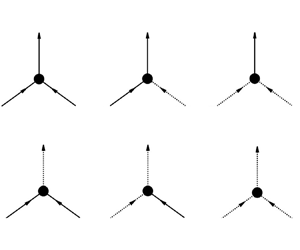Article contents
Generalised quasilinear approximations of turbulent channel flow. Part 2. Spanwise triadic scale interactions
Published online by Cambridge University Press: 30 June 2022
Abstract

Continuing from Part 1 (Hernández et al., J. Fluid Mech., vol. 936, 2022, A33), a generalised quasilinear (GQL) approximation is studied in turbulent channel flow using a flow decomposition defined with spanwise Fourier modes: the flow is decomposed into a set of low-wavenumber spanwise Fourier modes and the rest high-wavenumber modes. This decomposition leads to the nonlinear low-wavenumber group that supports the self-sustaining process within the given integral length scales, whereas the linearised high-wavenumber group is not able to do so, unlike the GQL models in Part 1, which place a minimal mathematical description for the self-sustaining process across all integral scales. Despite the important physical difference, it is shown that the GQL models in this study share some similarities with those in Part 1, i.e. the reduced multi-scale behaviour and anisotropic turbulent fluctuations. Furthermore, despite not being able to support the self-sustaining process in the high-wavenumber group, the GQL models in the present study are found to reproduce some key statistical features in the high-wavenumber group solely through the ‘scattering’ mechanism proposed by previous studies. Finally, using the nature of the GQL approximation, a further set of numerical experiments suppressing certain triadic nonlinear interactions are carried out. This unveils some key roles played by certain types of triadic interactions, including energy cascade and inverse energy transfer in the near-wall region. In particular, the inhibition of inverse energy transfer in the spanwise direction leads to suppression of the near-wall positive turbulent transport at large scales.
JFM classification
Information
- Type
- JFM Papers
- Information
- Copyright
- © The Author(s), 2022. Published by Cambridge University Press
References
REFERENCES
- 12
- Cited by


